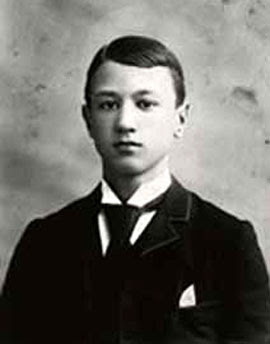
(Ives at 15 [1889], two years before the composition of Variations on America)
Charles Edward Ives (b. October 20, 1874, Danbury, CT – May 19, 1954) was born in Danbury, Connecticut, the son of George Ives, a U.S. Army bandleader in the American Civil War, and his wife Mary Parmelee. The father's unusual music lessons were a strong influence on the young composer. George Ives took an open-minded approach to musical theory, encouraging his son to experiment in bitonal and polytonal harmonizations. Charles would often sing a song in one key, while his father accompanied in another key. It was from his father that Charles Ives also learned the music of Stephen Foster.
Ives became a church organist at the age of 14 and wrote various hymns and songs for church services, including his Variations on America (1891, published in 1949), which he premiered at a recital celebrating the Fourth of July. The piece takes the tune (which is also known as My Country Tis of Thee, and the national anthem of the United Kingdom: God Save the King or God Save the Queen) through a series of witty and sharply-varied permutations,
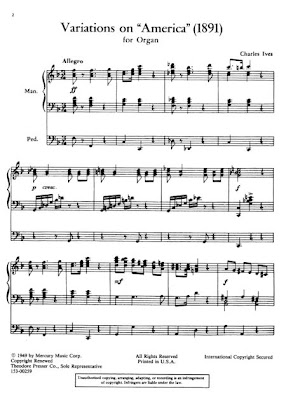
including an opening 3/4 fanfare,
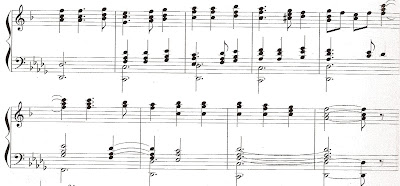
a bitonal (one of the first) nightmare,

a gimpy 6/8 frolic,

and a Spanish romp.
Melodically, F harmonic minor: Do Do Re Ti Do Re Me Me Fa Me Re Do Re Do Ti Do
Harmonically, i iio6 V7 i6 V7 i iio6 i64 V7 i iio6 i6 V7 i to M6 downbeat
William Schuman arranged the work for orchestra in 1964, heard here in an abbreviated form.
***
Ives moved to New Haven in 1893, graduating from the Hopkins School, and enrolling the next year (September 1894) at Yale University, studying under Horatio Parker. On November 4, Ives's father died, dealing a blow to the young composer, who idealized his father, and to a large degree continued the musical experimentation begun by him, writing The Circus Band (1896), and Symphony No. 1 in D Minor as a senior thesis under Parker's supervision.
Upon graduation in 1899, Ives began working for the insurance agency of Charles H. Raymond & Co, and found a much more radical approach, in such works as Psalm 100 (1899), with its strident "Make a Joyful Noise" bitonality (C: I bII bVII I in the lower chorus against C: I in upper -- with bII and bVII being simply alarming upper and lower neighbor chords (the lamentably distorted recording below excerpts the beginning and the end of the work).
***
In Symphony No. 2 (1902, though an analysis of handwriting and manuscript paper suggests 1907-1909), Ives utilized musical quotes (such as in IV. Allegro molto's use of Lowell's Mason's When I Survey the Wondrous Cross; and Columbia, Gem of the Ocean), unusual phrasing and orchestration, and a blatantly dissonant 11-tone chord at the close.
***
Symphony No. 3 ("The Camp Meeting") (1904)
***
Central Park in the Dark (1906) evokes an evening of Manhattan nightclubs in Manhattan (playing popular music, including ragtime and Hello, My Baby by Joseph E. Howard [1878-1961]) against the mysterious dark and misty qualities of the Central Park woods, played by the strings. The string harmony uses shifting chord structures in tertial, quartal, and quintal harmonies. Near the end of the piece the remainder of the orchestra builds up to a grand chaos ending on a dissonant chord, leaving the string section to end the piece save for a brief violin duo superimposed over the unusual chord structures.
1907 saw the failure of Raymond & Co. and the first of Ives's bout with bad health (characterized as "heart attacks" by his family). At this time, Ives and friend Julian W. Myrick formed their own insurance agency Ives & Co., which later became Ives & Myrick, where he remained until he retired.
During his career as an insurance executive, Ives laid the foundation of estate planning, achieving considerable fame and wealth (many of his profession were surprised to learn that he was also a composer). In his spare time he composed music and, until his marriage, worked as an organist in Danbury and New Haven as well as Bloomfield, New Jersey, and New York City.
**
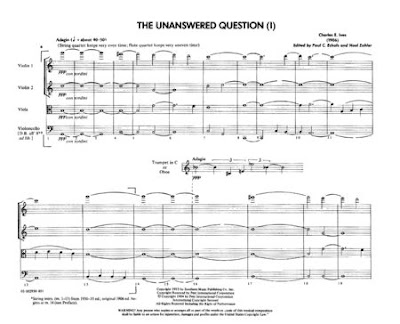
In The Unanswered Question (1908), the strings play very slow, chorale-like music throughout ("the silence of the druid"), as a trumpet occasionally iterates a short motif described as "the eternal question of existence." With each question comes increasingly shrill outbursts from the flutes -- apart from the last, which remains, yes, unanswered. The three disparate instrumental resources are designated to be spatially separate in performance (the recording below is of the final "make fun of the question" wind response, and the final insistent utterance of the trumpet).
Leonard Bernstein even borrowed its title for his Charles Eliot Norton Lectures in 1973.
**
In 1908, Ives married Harmony Twitchell and moved into an apartment in New York, continuing a remarkably successful career in insurance, and prolific, though unacknowledged, compositional life, until he suffered several heart attacks in 1918, after which he composed very little.
***
Piano Sonata No. 1 (c. 1909)
Piano Trio (c. 1909–10)
Violin Sonata No. 1 (c. 1910)
Violin Sonata No. 4 ("Children's Day at the Camp Meeting") (c. 1911)
Robert Browning Overture (c. 1912)

String Quartet No. 2 (c. 1913)
A Symphony ("New England Holidays"): The Fourth of July (1913) (The cacophonous, concluding fireworks display in contrary musics, with a sputtering out of ashes in descending strings)
General William Booth Enters Into Heaven [Are You Washed] (c. 1913) (the calm finale depicting the founder of the Salvation army's encounter with the Almighty in the Hereafter - in a diffuse trombonic setting of the revivalist hymn Are You Washed in the Blood -- and henceforth, marching on with his poor vagabonds to the dissonant downbeats of piano drumming)
Three Places in New England (Orchestral Set No. 1) (1914): II. Putnam's Camp (two excerpts in contrary George-Ives-marching-band style bimetrics, sometimes utilizing two conductors or two hands with a memorized score)
Violin Sonata No. 2 (c. 1914)
Violin Sonata No. 3 (c. 1914)
Orchestral Set No. 2 (c. 1915)
***
Ives described his Piano Sonata No. 2 ("Concord, Massachusetts, 1840-60") (1915) as an "impression of the spirit of transcendentalism that is associated in the minds of many with Concord, Mass., of over a half century ago...undertaken in impressionistic pictures of Emerson and Thoreau, a sketch of the Alcotts, and a scherzo supposed to reflect a lighter quality which is often found in the fantastic side of Hawthorne."
Rhythmically and harmonically, the work is adventurous, right down to its optional parts for flute and viola. In the second movement, Ives instructs the pianist to use a 14¾ in piece of wood to produce a dense but generally very soft cluster chord. III. Alcotts demonstrates Ives's fondness for the opening movement of Beethoven's Symphony No. 5 , with multiple dramatic usages.
***
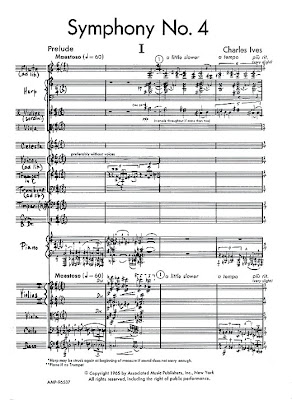
Symphony No. 4 (1916) [Quotation, Density, Fugue]
I. Prelude. Maestoso (for three contrary ensembles - offstage chamber group, onstage orchestra, and chorus singing the advent hymn Watchman Tell Us of the Night)
II. Comedy. Allegretto (a hustle-bustle of contrary musics)
III. Fugue. Andante moderato con moto
Beginning (an intentionally academic fugue, on the hymn tune From Greenland's Icy Mountains, noted in large pseudo-archaic note values -- subsidiary theme on another church melody, Crown Him Lord of All)
Ending (featuring an interior section of G.F. Handel's Joy to the World as its conclusion)
IV.
A complete performance of the symphony was not given until 1965, almost half a century after the symphony was completed, and more than a decade after Ives' death.
***
Serenity (1919) [Chant]
***
Ives's Concord Sonata and its accompanying prose volume, Essays Before a Sonata were privately printed in 1920.
In 1922, Ives published his 114 Songs, at his own expense, which represents the breadth of his work as a composer, including highly dissonant works such as The Majority. After seeing the volume during the 1930's, Aaron Copland published a newspaper article praising the collection.
***
Three Quarter-Tone Piano Pieces (1923) [This work, for two pianos tuned a quarter-tone apart, is an early example of microtonality in 20th-Century art music, and a jokey one at that, with quotations of America (My Country Tis Of Thee) once again]
***
Ives wrote his last piece, the song Sunrise, in August of 1926.
According to his wife, one day in early 1927 he came downstairs with tears in his eyes: he could compose no more, he said, "nothing sounds right." There have been numerous theories advanced to explain the silence of his late years, which seems as mysterious as the last several decades of the life of Jean Sibelius, who also stopped composing at almost the same time. While Ives had stopped composing, and was increasingly plagued by health problems, he did continue to revise and refine his earlier work, sometimes adding suspiciously modernist touhes to older works, as well as oversee premieres of his music.
After continuing health problems, including diabetes, in 1930 he retired from insurance, giving him more time to devote to his musical work, but unable to write any new music.
Remarkably, Ives, who actually avoided the radio and the phonograph, agreed to make a series of piano recordings from 1933 to 1943 that were later issued by Columbia Records on a special LP set issued for Ives' centenary in 1974 (New World Records issued 42 tracks of Ives's recordings on CD on April 1, 2006).
Ives continued to acquire more public recognition during the 1930's, with performances of a chamber orchestra version of his Three Places in New England both in the U.S. and on tour in Europe by conductor Nicholas Slonimsky and the New York Town Hall premiere of his Piano Sonata No. 2 by John Kirkpatrick in 1939, which led to favorable commentary in major New York newspapers.
At this time, Ives was also promoted by Bernard Herrmann, who worked as a conductor at CBS and in 1940 became principal conductor of the CBS Symphony Orchestra.
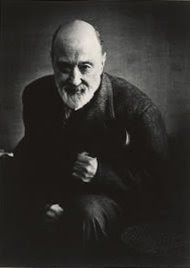
This was the decade when he met Lou Harrison, who began to edit and promote Ives's music, conducting the premiere of Symphony No. 3 (1904) in 1946. The following year, the work won the Pulitzer Prize for Music, the composer giving away the money away (half of it to Harrison), saying "prizes are for boys, and I'm all grown up."
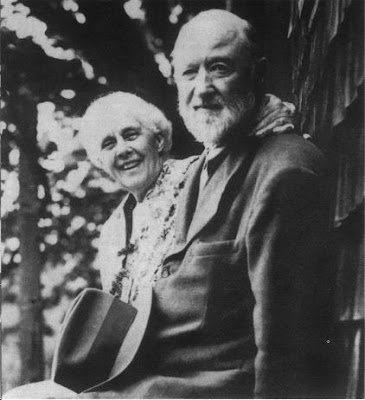
Ives revised and published his Concord Sonata in 1947 .

In 1951, Leonard Bernstein conducted the world premiere of Symphony No. 2 in a broadcast concert by the New York Philharmonic Orchestra; the Ives heard the performance on their cook's radio and were amazed at the audience's warm reception to the music.
Ives died in 1954 in New York City.
He left behind material for an unfinished Universe Symphony, which he was unable to assemble in his lifetime despite two decades of work, due as much to shifting conceptionsof the work as to ill health. There have been several attempts at completion or performing version.
Universe takes the ideas in the Symphony No. 4 to a higher level, with complex cross rhythms and layered dissonance along with unusual instrumental combinations.
Ives's music was largely ignored during his lifetime as an active composer, but since then his reputation has greatly increased.
One of the more damning words one could use to describe music in Ives's view was "nice", and his famous remark "use your ears like men!" seemed to indicate that he did not care about his reception. But Ives was interested in popular reception, but on his own terms.
Early supporters included Henry Cowell, Elliott Carter and Aaron Copland. Cowell's periodical New Music published a substantial number of Ives' scores (with the composer's approval), but for almost 40 years Ives had few performances that he did not arrange or back, generally with Nicolas Slonimsky as the conductor.
Later, around the time of the composer's death in 1954, Kirkpatrick teamed with soprano Helen Boatwright for the first extended recorded recital of Ives' songs for the obscure Overtone label (Overtone Records catalog number 7). Boatwright and Kirkpatrick recorded a new selection of songs for the Ives Centennial Collection that Columbia Records published in 1974.
Leopold Stokowski took on the Symphony No. 4 in 1965, regarding the work as "the heart of the Ives problem"; the Carnegie Hall world premiere by the American Symphony Orchestra led to the work's first recording.
Another major promotor of Ives was choral conductor Gregg Smith, who made a series of recordings of the composer's shorter works during the 1960s, including first stereo recordings of the psalm settings and arrangements of many short pieces for theater orchestra. During the 1960's, the Juilliard String Quartet recorded the two string quartets.
Michael Tilson Thomas is an enthusiastic exponent of Ives's symphonies as is composer and biographer Jan Swafford.
In 1991, Connecticut's legislature designated Ives as that state's official composer.
Musicologist D. G. Porter reconstructed a piano concerto, the Emerson Concerto, from Ives's sketches. A recording of the work was released by Naxos Records.
Ives was a great supporter of 20th-century music. This he did in secret, telling his beneficiaries it was really his wife who wanted him to do so. Nicolas Slonimsky said in 1971, "He financed my entire career."
[8875 Ravel / 8874 Charles Ives / 8874 Holst]
